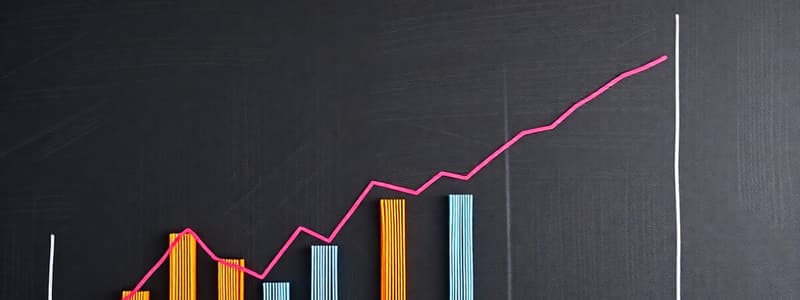Podcast
Questions and Answers
If selling and administrative expenses are allocated to different products, they should be reported as a
If selling and administrative expenses are allocated to different products, they should be reported as a
- period cost (correct)
- cost of goods manufactured
- factory overhead cost
- cost of goods sold
Activity rates are determined by:
Activity rates are determined by:
- Dividing the cost budgeted for each activity pool by the estimated activity base for that pool. (correct)
- Dividing the actual cost for each activity pool by the estimated activity base for that pool.
- Dividing the actual cost for each activity pool by the actual activity base for that pool.
- Dividing the cost budgeted for each activity pool by the actual activity base for that pool.
Which of the following does not rely on managerial decisions involving accurate product costing?
Which of the following does not rely on managerial decisions involving accurate product costing?
- Product constraints (correct)
- Product mix
- Product price
- Emphasis of a product line
Activity-based costing can be beneficial in allocating selling and administrative expenses to various products for managerial decision-making. Which of the following would be the best allocation base for help desk costs?
Activity-based costing can be beneficial in allocating selling and administrative expenses to various products for managerial decision-making. Which of the following would be the best allocation base for help desk costs?
Cost behavior refers to the manner in which a cost:
Cost behavior refers to the manner in which a cost:
Contribution margin is:
Contribution margin is:
Which of the following statements is true regarding fixed and variable costs?
Which of the following statements is true regarding fixed and variable costs?
Which of the following conditions would cause the break-even point to increase?
Which of the following conditions would cause the break-even point to increase?
If variable costs per unit increased because of an increase in hourly wage rates, the break-even point would:
If variable costs per unit increased because of an increase in hourly wage rates, the break-even point would:
Which of the following would be most likely to use process costing?
Which of the following would be most likely to use process costing?
Costs that are incurred in generating revenues during the period, but are not involved in the manufacturing process, are referred to as:
Costs that are incurred in generating revenues during the period, but are not involved in the manufacturing process, are referred to as:
Which of the following is not a characteristic of a job order costing system?
Which of the following is not a characteristic of a job order costing system?
Which of the following systems provides for a separate record of the cost of each particular quantity of product that passes through the factory?
Which of the following systems provides for a separate record of the cost of each particular quantity of product that passes through the factory?
Which of the following represents the factory overhead applied to a product?
Which of the following represents the factory overhead applied to a product?
Which of the following methods of applying the cost-plus approach to product pricing includes selling expenses, administrative expenses, and desired profit in the markup?
Which of the following methods of applying the cost-plus approach to product pricing includes selling expenses, administrative expenses, and desired profit in the markup?
Which of the following is not a commonly used approach to setting transfer prices?
Which of the following is not a commonly used approach to setting transfer prices?
The target cost is determined by taking:
The target cost is determined by taking:
When using the variable cost method of applying the cost-plus approach to product pricing, which of the following is included in the markup?
When using the variable cost method of applying the cost-plus approach to product pricing, which of the following is included in the markup?
Which of the following is not a method commonly used in applying the cost-plus approach to product pricing?
Which of the following is not a method commonly used in applying the cost-plus approach to product pricing?
The inventory costing method that reports the most current prices in ending inventory is:
The inventory costing method that reports the most current prices in ending inventory is:
Inventory turnover is expressed in terms of:
Inventory turnover is expressed in terms of:
Which of the following methods is appropriate for a business whose inventory consists of a relatively small number of unique, high-cost items?
Which of the following methods is appropriate for a business whose inventory consists of a relatively small number of unique, high-cost items?
Days inventory on hand equals 365 divided by:
Days inventory on hand equals 365 divided by:
An overstatement of ending inventory in one period results in:
An overstatement of ending inventory in one period results in:
Managerial accounting reports are:
Managerial accounting reports are:
The amount of income under absorption costing will be more than the amount of income under variable costing when units manufactured:
The amount of income under absorption costing will be more than the amount of income under variable costing when units manufactured:
Cost of goods manufactured is equal to:
Cost of goods manufactured is equal to:
The amount of income under absorption costing will be less than the amount of income under variable costing when units manufactured:
The amount of income under absorption costing will be less than the amount of income under variable costing when units manufactured:
Which of the following is the primary criterion for the preparation of managerial accounting reports?
Which of the following is the primary criterion for the preparation of managerial accounting reports?
Flashcards
Period Costs
Period Costs
A general term used to describe costs that are not directly related to the production of goods. They are incurred during a specific period in relation to the company's operations.
Factory Overhead Costs
Factory Overhead Costs
Costs associated with producing goods, but not directly tied to the materials or labor. It includes things like rent, utilities, and depreciation of factory equipment.
Cost of Goods Manufactured
Cost of Goods Manufactured
The total cost of goods that have been completed and are ready for sale.
Cost of Goods Sold
Cost of Goods Sold
Signup and view all the flashcards
Activity-Based Costing (ABC)
Activity-Based Costing (ABC)
Signup and view all the flashcards
Selling and Administrative Costs
Selling and Administrative Costs
Signup and view all the flashcards
Direct Cost
Direct Cost
Signup and view all the flashcards
Indirect Cost
Indirect Cost
Signup and view all the flashcards
Cost Allocation
Cost Allocation
Signup and view all the flashcards
Activity-Based Cost Allocation
Activity-Based Cost Allocation
Signup and view all the flashcards
Study Notes
Activity Based Costing
- If selling and administrative expenses are allocated to different products, they are reported as a period cost.
Studying That Suits You
Use AI to generate personalized quizzes and flashcards to suit your learning preferences.




